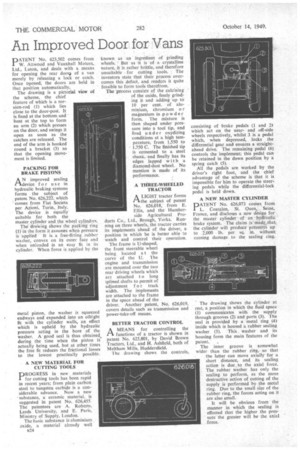An Improved Door. for Vans
Page 58

If you've noticed an error in this article please click here to report it so we can fix it.
DATENT No. 623,502 comes from W. Attwodd and Vauxhall Motors, Ltd., Luton, and deals with a means
for opening the rear door of a van merely by releasing a lock or catch. Once opened, the doors are held in that position automatically.
The drawing is a pictorial view of the scheme, the chief feature of which is a torsion-rod (1) which lies close to the door-post. It is fixed at the bottom and bent at the top to form an arm (2) which presses on the door, and swings it open as soon as the catches are released. The end of the arm is hooked round a bracket (3) so that the opening movement is limited.
PACKING FOR BRAKE PISTONS
AN improved sealing device for use in hydraulic braking systems forms the subject of patent No. 626,222, which ' comes from Fiat Societa per Azioni, Turin,.
The device is equally suitable for both the master cylinder and the wheel cylinders.
The dratving shows. the packing ring (1) in the form it assumes when pressure
is 'applied It is a free-fitting rubber washer, convex on its outer face and when unloaded is an easy fit in its cylinder. When force is applied by the metal piston, the washer is squeezed endways and expanded into an oiltight fit with the cylinder walls, an effect which is upheld by the hydraulic pressure acting in the bore of the washer. A good seal is thus obtained. during the time when the piston is actually being used, but at other times the free fit reduces the frictional losses to the lowest practically possible.
A NEW MATERIAL FOR CUTTING TOOLS
DROGRESS in new materials for cutting tools has been rapid in recent years; from plain carbon steel to tungsten carbide is a considerable advance. Now a new
• substance, a ceramic material, is suggested in patent No. 626,455. The patentees are A. Roberts, Leeds University, and E. Paris, Ministry of Supply, London.
The basic substance is aluminium axide, a material already well u24
known as an ingredient of grinding wheels. But as -it is -of• a crystalline nature, it is rather brittle, and therefore unsuitable for cutting tools. The inventors state that their process overcomes this defect, and renders it quite feasible to form tools therefrom.
The process consists of the calcining of the oxide, finely grindr ing it and adding -up to 10 per cent, of aluminium, chromium o r magnesium in powder form. The mixture is then shaped under pressure into a tool tip, and fired under oxydizing conditions at a high temperature, from 1,550 to 1,750 C. The finished tip is cemented to a steel shank,•and finally has its edges lapped with a diamond-dust wheel. No mention is made of its performance.
A THREE-WHEELED TRACTOR ik LIGHT tractor forms ri the subject of patent No. 626,018, from E. Ellis, and the Humberside Agricultural Products Co., Ltd., Brough, Yorks. Running on three wheels, the tractor carries its implements ahead of the driver, a position in which he is better able to watch and control their operation.
The frame is U-shaped, the front steerable wheel being located a t the curve of the U. The engine and transmission are mounted over the two rear driving wheels which are attached t o long splined shafts to permit of adjustment f o r track width. The implements arc attached to the frame in the space ahead of the driver. Another patent, No. 626,019, covers details such as transmission and power-take-off means.
BETTER TRACTOR CONTROL
A MEANS for controlling the functions of a tractor is shown in patent No. 625,801, by David Brown Tractors, Ltd., and H. Ashfield, both of Meltham Mills, Huddersfield.
The drawing shows the controls, consisting of brake pedals (I and 2) which act on the nearand off-side wheels respectively, whilst 3 is a pedal which, when depressed, locks the differential gear and ensures a straightahead drive. The remaining pedal (4), controls the implement; this pedal can be retained in the down position by a spring catch (5).
All the pedals are worked by the driver's right foot, and the chief advantage of the scheme is that it is impossible for him to operate the steering pedals while the differential-lock pedal is held down.
A NEW MASTER CYLINDER
PATENT No. 626,073 comes. from L. Coatalen, St. Quer]; •Seine, France, and discloses a new design for the Master cylinder of an hydraulic brake system. The claim is maderthat the cylinder will produce pressures up to .2,000 lb. per sq.in. without. causing damage to the sealing ring.
The drawing shows the cylinder at rest, a position in which the fluid space (I) communicates with the supply through grooves (2) and ports (3). The seal is provided by a metal ring (4) inside which is housed a rubber sealing washer (5). This washer and its housing form the main features of the patent. , The inner groove is somewhat wider than the rubber ring, so that the latter can move axially for a short distance, and its sealing action is due, to the axial force. The rubber washer has only the sealing to perform, as the more destructive action of cutting of the supply is performed by the metal ring. Due to the small size of the rubber ring, the forces acting on it are also small.
It will be obvious from the manner in which the sealing is effected that the higher the pressure the greater will be the axial force.




























































































